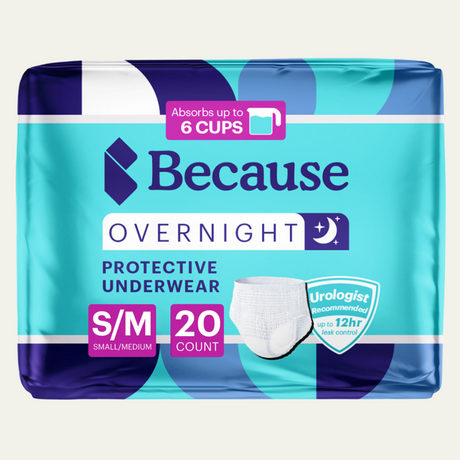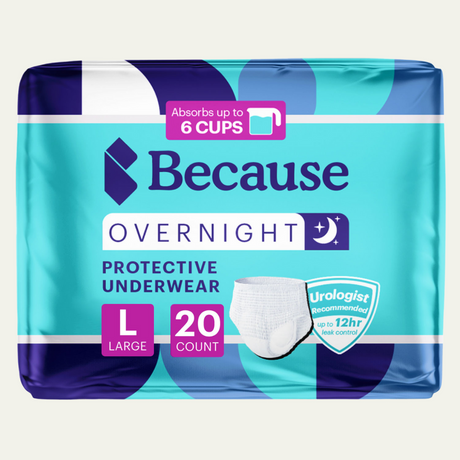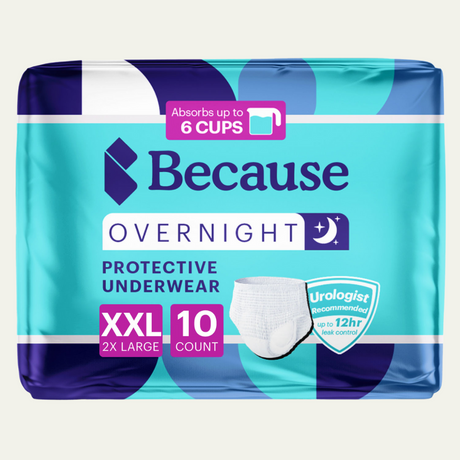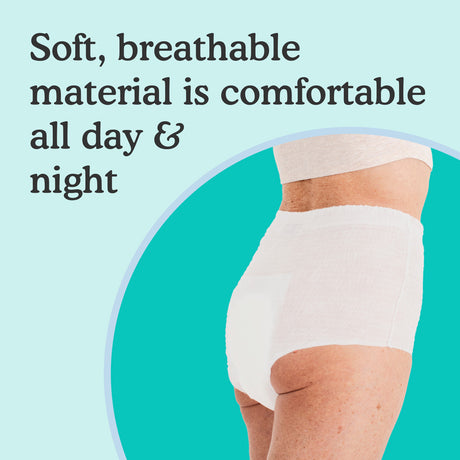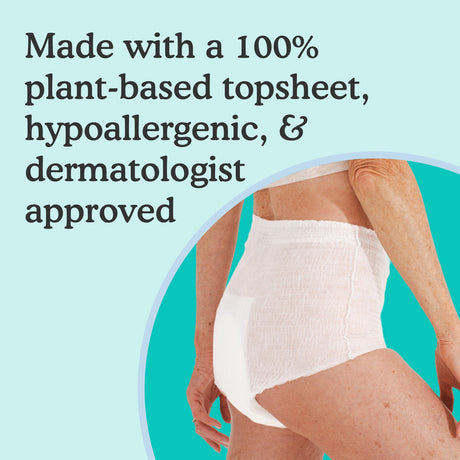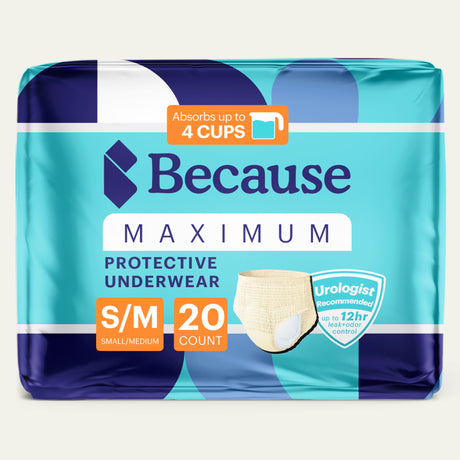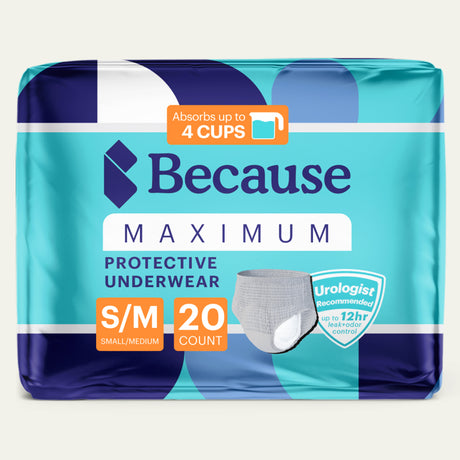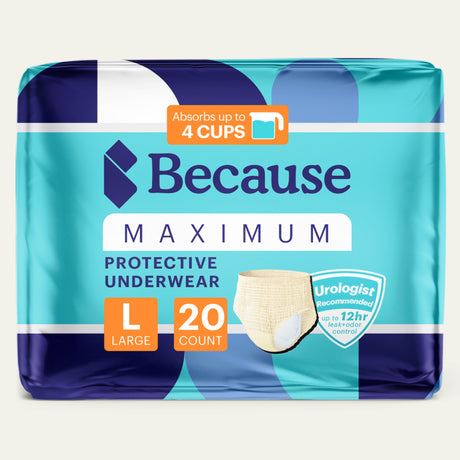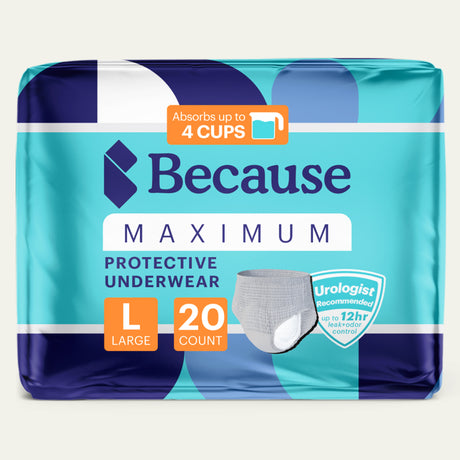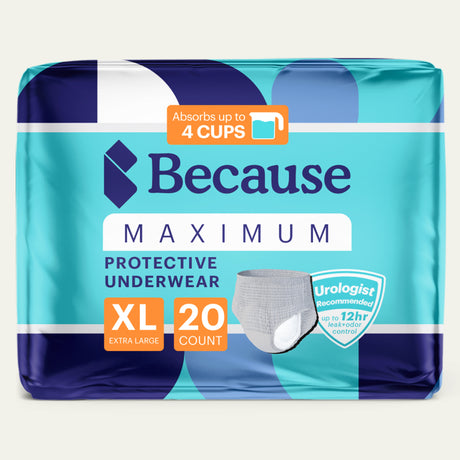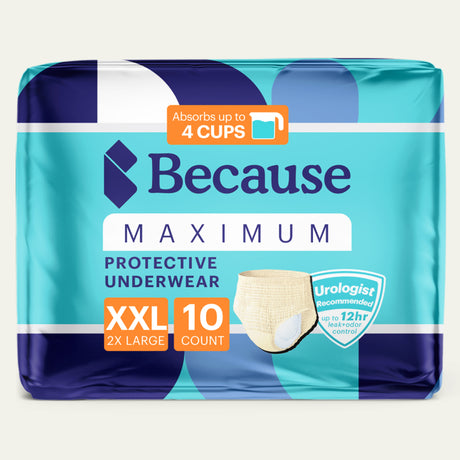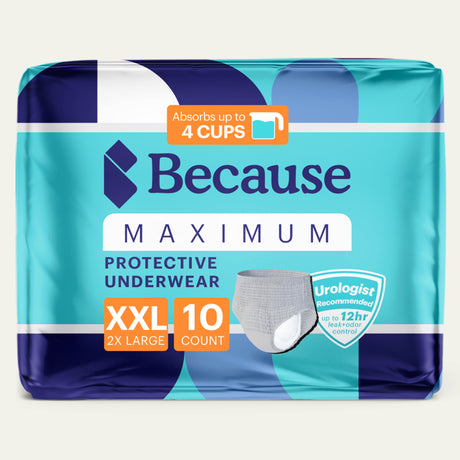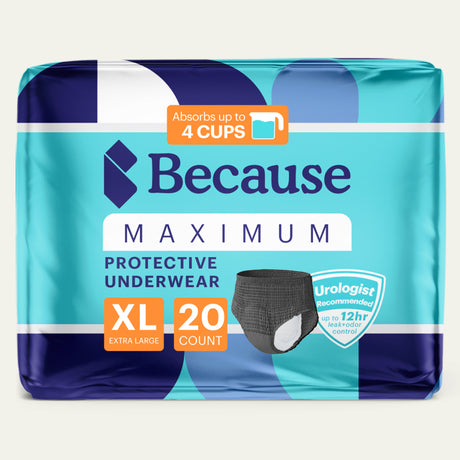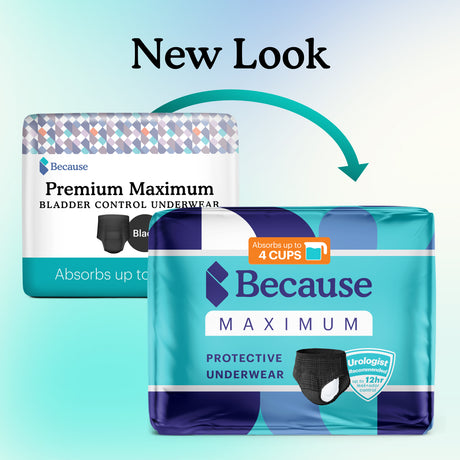Medically reviewed by Dr. Kerac Falk, MD, FACOG.
An estimated 20 to 80% of women develop uterine fibroids by the age of 50, and for some, fibroids cause noticeable symptoms. If you have been diagnosed with them and also experience incontinence, you may wonder whether bladder problems are possible symptoms of fibroids. In this piece, we’ll explore the connection between fibroids and urinary incontinence, explore treatment options, and discuss how you can manage incontinence in your daily life.
What Are Fibroids?
Fibroids are noncancerous growths that develop in or on the uterus. The most common symptoms of uterine fibroids include heavy menstrual bleeding, severe abdominal pain during periods, and an enlarged uterus and/or abdomen. However, many women experience no uterine fibroid symptoms at all.
Research has yet to uncover what causes the growth of fibroids, but there is a belief that both genetics and changes in hormone levels likely play a role.
There are three types of fibroids classified by the location of the fibroids in relation to the uterus. They are:
- Submucosal fibroids: inside the uterine cavity
- Intramural fibroids: within the uterine walls
- Subserosal fibroids: on the outside of the uterus

Can Fibroids Cause Incontinence?
Fibroids cause incontinence only in rare cases. Most often when a person has fibroids and incontinence, the growths aren’t the cause. The risk for urinary incontinence and fibroids increases with age, and obesity is a shared risk factor for both conditions. As a result, it’s possible for women to develop both fibroids and incontinence without one issue having caused the other.
What Types of Fibroids Can Cause Incontinence?
Ultimately, whether fibroids are the cause of urinary urgency, leakage, and other incontinence symptoms depends on the location of the fibroids. Larger subserosal fibroids are most likely to press on the bladder and potentially cause overactivity and leakage. However, as noted above, in most cases, even subserosal fibroids aren’t a cause of incontinence.

Diagnosing and Treating Incontinence Caused by Fibroids
In rare cases, where the growths are the direct cause of urinary symptoms, fibroid treatment is usually necessary to address incontinence. If you’re experiencing incontinence due to subserosal fibroids, your doctor will likely refer you to an expert, like a fibroid specialist, to explore your treatment options.
Fibroid diagnosis may involve:
- Ultrasounds performed through the lower abdomen or the vagina
- Magnetic resonance imaging (MRI) tests
- Hysterosalpingograms: X-rays taken after contrast dye injections are administered to the uterus
- Hysteroscopy: a specialized ultrasound technique where a doctor passes a scope through the vagina and cervix to view the uterus
Once your healthcare provider has diagnosed you with subserosal fibroids, they will develop a treatment plan based on the severity of the symptoms, the size of the fibroid, your medical history, and other factors. Fibroid treatment options include:
- Watchful waiting: If you have only a little discomfort and the severity of incontinence isn’t great, your medical provider may recommend that you do nothing beyond closely monitoring the fibroids through regular checkups.
- GnRH agonists: Medications like goserelin, leuprorelin, and triptorelin block the body from producing female sex hormones, stopping menstrual periods, and potentially shrinking fibroids.
- Drugs for menstrual symptoms: GnRH antagonists, tranexamic acid, low-dose birth control pills, and other medications may be prescribed to address fibroid symptoms, like heavy bleeding.
- Focused ultrasound surgery: A newer noninvasive treatment that involves a doctor using an MRI machine and an ultrasound device to focus sound waves on a fibroid to heat it up and destroy the tissue.
- Uterine fibroid embolization (UFE): A minimally invasive procedure that involves injecting arteries within the uterus with embolic agents that prompt them to shrink and die. In turn, this causes fibroids to shrink and reduces symptoms like heavy periods and incontinence. This may impact the future ability to become pregnant, due to interruption of blood supply.
- Radiofrequency ablation: Another minimally invasive technique for fibroid treatment that involves heating up fibroids with a device inserted either through the vagina or through a small incision in the abdomen.
- Myomectomy: Myomectomy is the term for surgical procedures that result in the removal of fibroids. Myomectomy procedures may be minimally invasive robotic or laparoscopic procedures or more invasive open surgery, depending on the size and location of the growth. Myomectomy is usually only recommended in women who desire future pregnancies.
- Hysterectomy: The most definitive treatment option, which involves the removal of the uterus. This can often be done in a minimally invasive manner, but sometimes open abdominal surgery is required. It is the only known permanent treatment for fibroids, but future pregnancies would not be an option after the uterus is removed.
Generally, healthcare providers will recommend more conservative treatments first and turn to more invasive procedures only when a woman experiences severe symptoms that aren’t alleviated by other interventions.
Living With Fibroids and Incontinence
Issues with fibroids and the incontinence symptoms that they can sometimes cause can be an ongoing problem. Conservative treatments can provide relief for months or even years, but fibroids and their accompanying symptoms may return in the future.
As a result, learning how to manage the symptoms of urinary incontinence from day to day is an important part of treatment. Keep reading to learn more about how to cope with incontinence due to fibroids.
Managing Incontinence Day-to-Day
To manage incontinence, follow these tips:
- Use incontinence protection products: Incontinence pads and underwear absorb and lock away urine to help you stay dry during the day. For women, there are moderate, maximum, and overnight absorbency options available. If you experience only light occasional leaks, less absorbent products may be adequate, while the highest absorbency pads and underwear are ideal for more severe symptoms.
- Change your incontinence protection frequently: Changing your pad or underwear as soon as possible after you experience leakage can help control odors. Be sure to wash your hands before and after you change your incontinence protection products.
- Cleanse with every change: When you change your incontinence protection, cleanse your private area with a no-rinse spray or wipes.
- Practice good incontinence skin care: Exposure to urine can lead to skin irritation, but you can reduce the risk of it developing by applying a barrier cream after you use a cleansing spray or wipes.
- Dispose of incontinence products properly: When you change your pad or underwear, place it inside a disposal bag to reduce odors and keep conditions sanitary
Can you use incontinence products for menstrual protection?
Women with fibroids may experience both urine leakage and heavy menstrual bleeding, leading to questions about how to manage both. The truth is that menstrual pads and incontinence pads have different designs, and they do not work well interchangeably.
To manage both incontinence and your menstrual flow, you can use tampons or a reusable menstrual cup with incontinence pads or underwear. Another option is to wear a booster pad or bladder control pad inside of absorbent menstrual underwear.
Lifestyle Strategies to Manage Incontinence
Making lifestyle changes can help address symptoms of incontinence and support a healthy urinary system. Some changes you can make include:
- Drinking enough water daily
- Cutting back on foods and drinks that can irritate the bladder, like caffeine, spicy foods, and acidic foods
- Limiting your intake of alcohol
- Quitting smoking
- Achieving or maintaining a healthy weight through diet and exercise
- Performing pelvic floor exercises to strengthen the muscles that support the bladder
- Employing bladder training strategies by making trips to the bathroom on a set schedule, regardless of whether you feel the urge to go
Seeking Emotional Support
Incontinence can affect your mental health as much as it does your body. Consider making an appointment with a mental health professional to discuss your thoughts and feelings. You can also confide in friends and family and join online or in-person support groups for people living with fibroids and/or incontinence.

The Importance of Regular Checkups and Early Detection
Seeing your healthcare provider regularly can help you catch fibroids early when they are easiest to treat and less likely to cause severe symptoms. If you’ve noticed any signs of uterine fibroids, such as pelvic pain, heavy periods, or incontinence, talk to your healthcare provider.
Do you struggle with incontinence? Take our bladder protection quiz and get a sample pack to try.
If you're struggling with incontinence, join one of our private support groups today!
Women's Incontinence Support Group
Men's Incontinence Support Group
About the Expert:
Dr. Falk is a fellowship-trained urogynecology subspecialist, double board-certified in both Obstetrics and Gynecology, as well as Female Pelvic Medicine and Reconstructive Surgery. He has expertise in the treatment of female pelvic floor disorders, which encompass many common but infrequently-discussed conditions which significantly impact women’s quality of life. These include complex disorders such as urinary and bowel incontinence, pelvic organ prolapse, childbirth injury, genital fistulas, recurrent urinary tract infection, and bladder pain.
Source:
U.S. Department of Health & Human Services, Office on Women's Health. (Feb. 19, 2021.). Uterine Fibroids. https://www.womenshealth.gov/a-z-topics/uterine-fibroids


